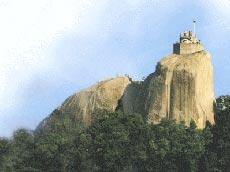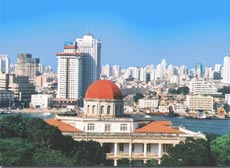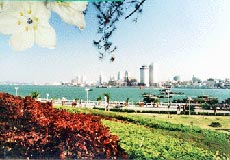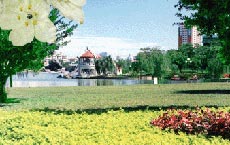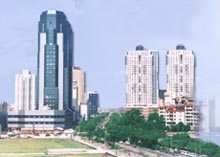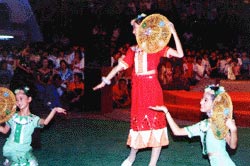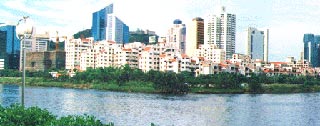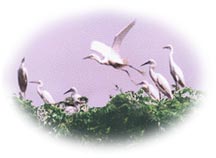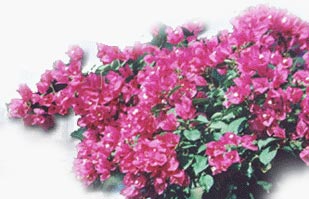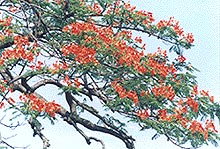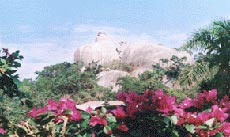History Xiamen
It is said that in the ancient time, flocks of egrets (Bailu in Chinese) migrated to dwell on Xiamen Island from time to time and that is why people call Xiamen "Ludao" (Island of Egrets) and Xiagu Strait "Lujiang" (River of Egrets). The first settlement of people on Xiamen Island dates back to the latter part of the New Stone Age. That was three to four thousand years ago. And the recorded history dates back to the middle period of the Tang Dynasty, |
|
which was more than 1140 years ago. During the Tianbao Period of the Tang Dynasty, the ethnic Chinese surnamed Xue (?) and Chen (?) migrated to Xiamen Island from Fu'an in the east of Fujian Province and Zhangzhou in the south of Fujian Province and settled at the southern and northern foot of the Hongjishan Mountain respectively.
The administrative organization of Xiamen City was first set up in the Song Dynasty. It was then affiliated to Tongan County, Quanzhou Prefecture. In the twentieth year during the Hongwu Period in early Ming Dynasty (1387), the imperial government started to build stockade villages and forward posts on the island and named the island "Xiamen", meaning the "Gate of the Motherland". And the geographical name of "Xiamen" became the official name of the island despite that Xiamen was once renamed "Siming Prefecture" and "Siming County" during the several hundred years from then on. In 1933, Xiamen was officially established as a city. That made it the first city set up in Fujian Province.
Geography Xiamen
|
Xiamen is a scenic coastal city in Southeast China. It is located at 24°22´-24°56´ North Latitude and 117°53´ -118°23´ East Longitude in the southeastern part of Fujian Province. It is from there that Jiulongjiang (Nine Dragon River) empties into the sea. Xiamen City sits in front of Zhangzhou and Quanzhou plains and borders on Taiwan Strait. It stands opposite to Taiwan and the Penghu Islands at a distance. |
Xiamen City consists of Xiamen Island, Gulangyu Island and part of the coastal area in the northern bank of Nine Dragon River. It covers an area of 1,565 square kilometers. There are seven districts, namely, Kaiyuan, Siming, Gulangyu Island, Huli, Jimei, Xinglin and Tong'an under the jurisdiction of Xiamen, with a registered population of 1.2659 million people. By the end of 1998, the constructed area of Xiamen City had reached 70.18 square kilometers.
Climate Xiamen
Xiamen enjoys subtropical oceanic climate. In most time of the year, it has warm and rainy weather without extreme heat in summer nor extreme cold in winter. The annual temperature averages 21? and the rainfall averages 1,100 millimeters a year with northeast wind prevails all year round. Affected by the abrupt changes of temperature and the air currents from the Pacific Ocean, |
|
Typhoon attacks Xiamen five to six times a year, occurring mostly between July and September.
Natural and Ecological Environment Xiamen
|
In recent years, Xiamen City has made great progress with marked achievements in terms of harnessing the ecological and natural environment in a comprehensive way. In 1995, Xiamen won the title of "China's Advanced City in Terms of Comprehensive Management of the Environment" and came in the first place in terms of the environmental sanitation in the appraisal organized in 35 big and middle-sized cities; |
in May of 1996, Xiamen City was granted the title of "One of China's Cleanest Cities". According to Xiamen City Environmental State Bulletin released by the Municipal Bureau of Environmental Protection, during the year of 1997, the municipal government put a total of 180 million yuan into the green project, which includes planting more trees in the urban gardens and parks and reinforcing the shelterbelts around the city. As a result, 163.9 hectares of new gardens and green areas emerged in the city, which made the coverage of green areas in the urban area reach 35.4% and the public green area per capita approaches 9.9 square meters. In the year of 1997, Xiamen City generated 2,735,000 tons of garbage, all of which have been properly disposed of. A percentage of 94.88% of domestic garbage was duly treated. And as much as 2,498,000 tons was treated in a harmless way. The air quality of Xiamen City remained good and among the best of the country's separately listed cities. In 1997, the air pollution index (API) in the urban area of Xiamen City was 36. the daily and yearly average values of sulfur dioxide, nitro-oxides and the suspended particles-three of the four key indices used for assessing air quality, maintain within the range of first-rated standards. In July of 1998, the API of Xiamen City was 28. After analyzing the 14 items selected for assessing the quality of the source of drinking water in the quantitative examination with respect to the comprehensive control of urban environments, 97.2% of Xiamen's drinking water comes up to the relevant standard in terms of the quality of source. In 1997, the environmental noise in the urban area averaged 56.5 decibels. In order to get a clearer picture of the average level of noise in the tourist attractions of the city, the Municipal Bureau of Tourism entrusted the municipal environment monitoring station to arrange for a special survey of the noise level in eight selected tourist attractions. The survey found that the average round-the-clock level of noise in the eight attractions averaged 55.48 decibels.
Economy Xiamen
With the approval of the State Council, a special economic zone (SEZ) was established in an area of 2.5 square kilometers in the northwest of Xiamen City in October, 1980. in March, 1984, the SEZ was enlarged to the whole island of Xiamen (including Gulangyu Island), covering an area of 131 square kilometers and the policy of free port was gradually introduced into the SEZ. In May 1989, an investment zone enjoying the same treatment as the SEZ exclusively open to Taiwanese investors was set up in Xinglin, |
|
Haicang and Jimei (three districts of Xiamen City) with the approval of the State Council. In November 1992, Xiangyu Island Tax Bond Area was formed, again with the approval of the State Council.
Ever since Xiamen became a special economic zone, the municipal government has always been adhering to the fundamental policy of reform and opening-up. By taking full use of its geographical advantage, Xiamen has absorbed a huge amount of foreign capital, especially the funds from the overseas Chinese and Taiwanese to promote the economic integration among the enterprises of similar product structures. Now Xiamen has formed an export-oriented economic pattern with developing industry as the priority and three industries developing in a balanced way. After more than a decade's continuous improvement, Xiamen SEZ has created a relatively favorable investment environment and the foreign-invested companies have become an important force in developing the SEZ's export-oriented economy.
After years of construction, Xiamen City has now become a scenic coastal city boasting of complete infrastructure and robust internationally and domestically economic activities from a once closed and underdeveloped island. It ranks in the tenth place among the Chinese cities in terms of comprehensive economic strength. It is also one of the 40 Chinese cities with attractive physical investment environment.
Currently, Xiamen has defined its development target for the 21st century. The basic guideline for developing industries is to expand and adjust the secondary industry, vigorously develop the tertiary industry, optimize and upgrade the primary industry. The priorities in the development of industries will be in the following seven sectors: industry adopting advanced technology, communication and transportation, foreign and domestic trade and commerce, banking and insurance, tourist service, construction and real estate and information telecommunication.
Culture Xiamen
|
Since the adoption of reform and opening-up policy, Xiamen's cultural, broadcast and television undertakings have been forging ahead and bringing about changes day after day. Wireless and cable TV stations, AM and FM radio stations are trying their best to attract audience.Daily and evening newspapers, commercial journals and TV weekly are acclaimed by readers of different levels. |
More than 300 cinemas and theaters, cultural centers, libraries, museums, singing and dancing troupes, singing and dancing halls distributed in different parts of the city provide the citizens with rich cultural life. International cultural training and exchanges in different forms at different levels are conducted frequently.
A Survey of Tourist Industry Xiamen
Xiamen is a beautiful "seaside garden". "A city in the sea and sea in the city" is a vivid description of Xiamen. Islands and islets, cliffs and crags, rocks and stones, temples, subtropical flowers and trees, set off each other more beautifully. Xiamen is famous for its large number of overseas |
|
Chinese and that forms the basis for Xiamen to become a city blending local conditions and Taiwanese customs, delicious seafood and exotic buildings. Such pleasant climate as warm as in spring all year round is another feature attractive to tourists visiting this seaside city. Xiamen is located opposite to Taiwan and the Southeast Asia across the Taiwan Strait. This geographical advantage and the complementary transport facilities including waterways, land roads and airways are also powerful force for the sustained development of Xiamen's tourist industry.
Xiamen started to develop its tourist industry shortly after the founding of New China. In November 1949, Overseas Chinese Travel Service Xiamen, i.e. Xiamen China Travel Service was founded, which was actually the first travel agency formed in New China. With the adoption of reform and opening up policy, Xiamen's tourist industry emerged as a flourishing industry. From 1991 to 1998, the number of foreign tourists visiting Xiamen, the days the tourists spend sightseeing in Xiamen and the (foreign exchange) income from tourism come in the tenth place for successive 8 years among the tourist cities nationwide. The domestic tourism has also been making impressive progress. Now Xiamen has been listed as one of the tourist cities of China with its outstanding performance in developing tourism during the last decades and the tourist trade has become one of the key economic sectors and a new economic growth point for the Xiamen City.
With a view to building Xiamen into a "seaside garden" as a burgeoning tourist city, the quality of Xiamen's tourist trade has been markedly improved. It has also made great progress in expanding the tourist markets both at home and abroad. In the respect of the legislation in tourism, Xiamen City has promulgated its own regulations and rules in order to standardize the business activities of the tourist trade in Xiamen. They include the Management Regulations Governing Xiamen's Tourism, the Temporary Provisions Concerning the Protection and Development of Tourist Resources in Xiamen, the Measures to Regulate the Designated Tourist Units in Xiamen and the Temporary Provisions Concerning the Regulation of One-day Excursion Routes in Xiamen, etc. The above papers and documents together constitute the basic legislation in regulating the local tourism and have contributed to creating a favorable condition for "governing the tourist trade according to regulations and rules". With respect to the development of tourist resources, Xiamen has established more than ten tourist attractions including Gulangyu Island, Ten Thousand Stone Hill (Wanshishan), South Putuo Temple, Jimei Village of Scholars, etc. And the Gulangyu Island-Ten Thousand Stone Hill Tourist Route has been designated as one of the country's major scenic spots by the State Council. Especially, in order to make Xiamen a city more attractive to foreign companies and individual investors, it has completed the construction of the following new tourist projects since 1995-Xiamen Film and Television Recreational City, Taiwan Folk Custom Village (i.e., the Jingzhou Amusement Park), Undersea World in Gulangyu Island, Rongguang Treasures Museum on Hulishan Fortress, City of Aeronautical Science and Technology in Jimei, Oriental (Dongfang) Country Golf Club and Triumphant (Daige) Country Golf Club, both of which are designed and constructed according to the international standards. All the above entertainment facilities have been open to public. As for the tourist hotels and travel agencies, Xiamen City currently has 79 hotels capable of receiving foreign tourists, of which 45 are four-star rated hotels with more than 10,200 guestrooms; and some 340 middle and small-sized social hotels with about 2,200 beds. There are 12 international travel agencies and 36 domestic travel agencies and over 200 public places of entertainment. During 1998, Xiamen entertained 483,500 overseas tourists and 5,855,200 domestic visitors, which brought in $239 million of foreign exchange and 5.576 billion yuan in CNY respectively. The increased return from the tourist trade contributes to a 6% rise in the municipal GDP.
To get ready to meet the new challenge of the new century with more vigorous force, Xiamen has defined its trans-century target in developing tourist industry-to build Xiamen into a major tourist port in Southeast China and seaside tourist city of the country attractive to international sightseers and holiday makers with complete tourist infrastructure and recreational facilities.
City Bird of Xiamen
|
Egrets are the world's rare birds. They belong to heron family of bird class. Xiamen boasts small egrets, middle egrets, large egrets, Chinese egrets and gray egrets, which dwell on the island as the only five types of herons ever seen in China. People choose to call them egrets (Bailu in Chinese) collectively because they,except the gray egrets which have dark gray body-feathers, have beautiful snow-white feathers. The small and middle egrets are of the largest numbers and are seen more frequently. |
On October 23 of 1986, at the 23rd Session of the Standing Committee of the 8th Municipal People's Congress it was decided that the egret be the City Bird of Xiamen.
The City Flower of Xiamen-Triangular Shaped Plum Blossom Xiamen
The Standing Committee of the Eighth People's Congress of Xiamen City decided the matter on October 23, 1986 in its 20th conference. The scientific name of the flower is Bougain Villeasp. It is an evergreen clamber bush or a hanging down shrub, which belongs to the category of bougain of the bongainvillea family. It is a wood nature liana. The nature of its leaves has the luster. |
|
Its flower is small and opens on the top. The flower usually grows in clusters in the bud plate. The three big bud plates are very distinctive, constructing a major object sight for enjoying. In ancient times, it was called "Nine Layers of Vine". It is called "Leaves Tiny Flower" and "Triangular Flower" in North China and it was called "Bougain" as translated in sound from English in Hongkong. It was originally planted in Brazil of South America and it is a long time since it was imported and planted in China in 1972.
It has a great number of varieties, and large amount of colors. It has the nurture color of red, orange, yellow, white and purple, and it has the shape of single petal flower, double petal flower and mottled plate flower etc. it couples hardness with softness, and it is simple and unadorned. It is easy to plant and possesses much variety of colors, so it can be used to make potted landscape. As a result, to use the Triangular Shaped Plum Blossom as the city flower, to plant it broadly and to take care of it will not only afforest and beautify Xiamen, but also better show the style and features of Xiamen, the character of Xiamen people and the rapid development of the Xiamen Special Economic Zone.
The City Tree of Xiamen-Phoenix Tree.
|
The Standing Committee of the Eighth People's Congress of Xiamen City decided the matter on October 23, 1986 in its 23rd conference. Phoenix Tree is also called "Red Pillars" or "Flamboyant Tree". It is a deciduous arbor belonging to leguminous family. It can be as tall as 20 meters. The crown of the tree is very broad with binatopinnate double leaves. There are 10~24 pairs of plumed plate. Each plumed plate has 20~40 pairs of small leaves. |
The little leaves appear to be long ellipse shape. The tree will blossom in summer with botrus big flowers of red color and luster. The legume has the nature of wood with a length of 50 centimeters. It was originally planted in Africa. There are a lot of the trees planted in the south of our country. It is a beautiful tree for courtyard and street. With elegant branches and beautiful leaves, it is a typical southern China tree. In the summer days, the trees can provide shady and cool atmosphere to the city. The red flowers showed cluster after cluster representing the construction field, which is like a raging fire of the Special Economic Zone. It also represents the features of Xiamen, the character of Xiamen people and the rapid development of the Xiamen Special Economic Zone.
Tourism Logo of Xiamen
The Crag of Sunlight (Riguangyan) is popularly called Dazzling Crag (Huangyan). It sits on the top of the Dragon's Head Hill (Longtoushan) in the mid-south of Gulangyu Island. Standing 92.68 meters above the sea level, the summit of Dragon's Head Hill is the highest peak on the Island. On top of the Crag a round platform is built for visitors to lean on the railing and look far into the distance so as to have a bird-eye view of the overall landscape of Xiamen and Gulangyu Islands. |
|
It is this very platform that was selected to serve as the tourist logo of Xiamen City. |
